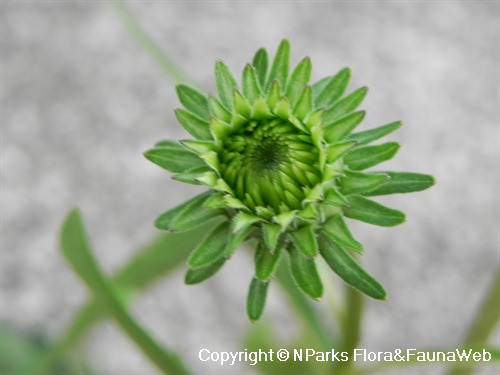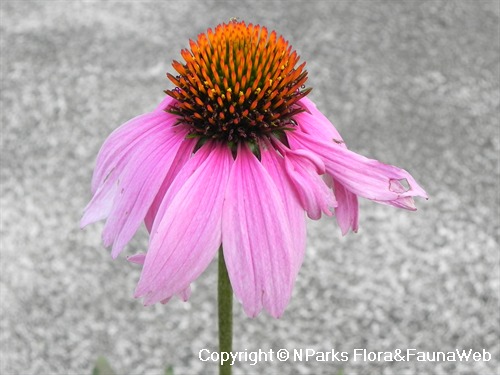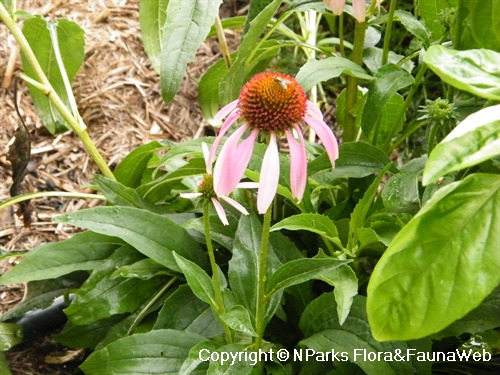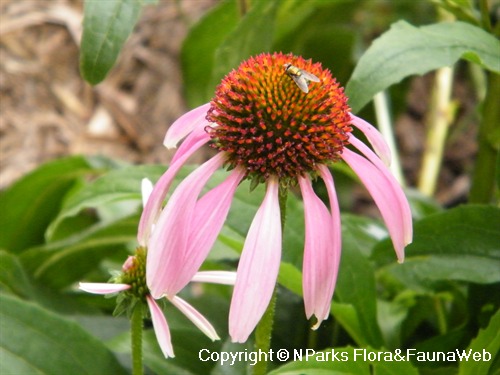
Back
Echinacea purpurea (L.) Moench
| Family Name: | Asteraceae (Compositae) |
| Common Name: | Eastern Purple Coneflower |
Name
Classifications and Characteristics
| Plant Division | Angiosperms (Flowering Seed Plants) (Dicotyledon) |
|---|---|
| Plant Growth Form | Herbaceous Plant |
| Lifespan (in Singapore) | Perennial |
| Mode of Nutrition | Autotrophic |
| Maximum Height | 0.6 m to 1.5 m |
| Maximum Plant Spread / Crown Width | 0.5 m to 0.6 m |
Biogeography
| Native Distribution | Eastern North America |
|---|---|
| Native Habitat | Terrestrial |
| Preferred Climate Zone | Sub-Tropical / Monsoonal, Temperate |
Description and Ethnobotany
| Growth Form | Perennial herb up to 1.5 m tall which grows in clumps. |
|---|---|
| Foliage | Leaves are ovate to ovate-lanceolate, with serrate margins. |
| Stems | The stems are hairy. |
| Flowers | The inflorescence is a head (capitulum), with many ray flowers surrounding the central disc flowers. The ray flowers are drooping, purple or pinkish colored. |
| Habitat | Founded in open, wooded regions. |
| Cultivation | This easy-to-grow plant tolerates infertile soil, drought and heat. It grows best in full sun but also tolerates light shade. |
| Etymology | The genus Echinacea means hedgehog or sea urchin in Greek ('echinos'), referring to the spiky nature of the cone located in the centre of the flower. The specific epithet purpurea means purple, referring to the colour of the petal-like ray florets. |
| Ethnobotanical Uses | Medicinal: Plant extracts of Echinacea purpurea are sold singly or in combination with extracts from Echinacea angustifolia and/ or Echinacea pallida as an herbal supplement that helps to stimulate the immune system and prevent/ treat colds. Some clinical studies conclude that these supplements are helpful to prevent or shorten the duration of a cold, while other studies indicate they are not effective. |
Landscaping Features
| Desirable Plant Features | Ornamental Flowers |
|---|---|
| Landscape Uses | Parks & Gardens, Small Gardens |
Fauna, Pollination and Dispersal
| Fauna Pollination Dispersal Associated Fauna | Butterfly-Attracting |
|---|---|
| Pollination Method(s) | Biotic (Fauna) |
Plant Care and Propagation
| Light Preference | Full Sun, Semi-Shade |
|---|---|
| Water Preference | Moderate Water |
| Plant Growth Rate | Slow |
| Rootzone Tolerance | Drought Tolerant, Well-Drained Soils, Poor Infertile Soils, Easy to Grow |
| Propagation Method | Seed, Root Cutting, Division |
Foliar
| Mature Foliage Colour(s) | Green |
|---|
Floral (Angiosperm)
| Flower Colour(s) | Pink, Purple |
|---|---|
| Flower Grouping | Cluster / Inflorescence |
| Inflorescence Type | Compound Head / Capitulum |
Image Repository
Others
| Master ID | 30572 |
|---|---|
| Species ID | 4881 |
| Flora Disclaimer | The information in this website has been compiled from reliable sources, such as reference works on medicinal plants. It is not a substitute for medical advice or treatment and NParks does not purport to provide any medical advice. Readers should always consult his/her physician before using or consuming a plant for medicinal purposes. |



